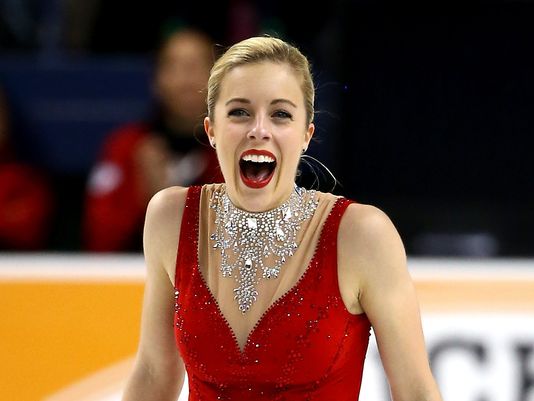If you asked me four years ago when I was watching the Olympics that took place in Vancouver if I was live-tweeting the results of the Pairs Figure Skating event, I’d give you a puzzled look; just like the ones Johnny Weir and Tara Lipinksi give Terry Gannon when he tries to make golf analogies during figure skating coverage.
Without question, social media has dominated these Olympic games. NBC, the American network with broadcast rights to the games, the IOC, and the U.S. Olympic Team, among other large organizations affiliated with the Olympics, each have their own Twitter account(s). They update them constantly with endless hours of video coverage, photographs, and live updates from the slopes and ice. However, the most amazing part about the increased access to the games does not come in the form of pre-planned, canned tweets from broadcasters who may never have performed a free skate or ever strapped a snowboard to their boots. Increased access to the games also means increased public access to the athletes, making everyone around the world feel a personal connection to the Olympics in ways never previously felt.
The 2012 London Olympics were dubbed the “Social Olympics,” because it was truly the first time where athletes had unprecedented access to the Internet, and social media sites like Twitter, which are designed for updating “followers” frequently, became incredibly popular. Although Twitter and Facebook existed during the 2010 Vancouver games, and the 2008 Beijing games, neither of these two events garnered as much social media traction as 2012. In Beijing, athletes’ access to the Internet was limited due to China’s tech policy, which debilitates and quashes freedom of speech and access to websites. In Vancouver, Twitter simply wasn’t popular enough to have the intense coverage that 2012 gave the social media site.
If 2012 was the “Social Olympics,” then 2014 will be dubbed the “Viral Olympics.” Between Jason Brown’s ponytail having its own Twitter account, Ashley Wagner memes, Sage Kotsenburg’s “The Holy Crail” trending on Twitter, or the American skier who saved stray puppies that were roaming Sochi, the personal lives and stories of these athletes are reported on in ways we never previously imagined or experienced. #SochiProblems began trending almost instantly.
Watching the games with my friends, we felt a personal connection to figure skater Jason Brown, whose video (filmed by coach Kori) of him singing his own rendition of Take a Look at Me Now by Phil Collins made us laugh until we cried. Even before the games Jason’s performance to Riverdance at the U.S. National Championships (which earned him a ticket to Sochi) went viral due in part to a Buzzfeed article. His electric personality reverberates through the TV or computer screen, and we can’t help but grin as big as Jason does whenever we see him.
An even bigger reason for the increased personal connection I have to these games has been the response by the athletes to my tweets, and other fans’ as well. Over the course of the past two weeks, I’ve live-tweeted the figure skating events, including all team events, and the pairs and men’s singles. During this time, I’ve reached out to many figure skaters, including 2007 World Champion Kimmie Meissner, 9 Time U.S. Champion and diplomat Michelle Kwan, 2014 U.S. Olympians Jason Brown, Marissa Castelli, and Felicia Zhang and Ashley Wagner, and the 2014 Men’s figure skating Bronze Medalist Denis Ten, who competed on behalf of Kazakhstan. To my surprise, all of them acknowledged my tweets in some way, whether it was just a “favorite,” a retweet, or even a full-fledged conversation.
Jason Brown and Michelle Kwan have favorited numerous tweets of mine, and Kwan has even responded to me during a Twitter town hall when I asked a question about her new role at the Department of State’s Bureau of Educational and Cultural Affairs.

Felicia Zhang and her partner Nate Bartholomay were absolutely beautiful in their free skate performance in the pairs event, and they were one of few teams to skate a clean performance: no falls. I made sure to let her know how impressive I thought this was, tweeting at her and Marissa Castelli throughout the pairs event. Once the event was over, Felicia went through my page and favorite or retweeted EVERY tweet I posted about her. Marissa Castelli’s mom even found my tweet about Marissa and her partner Simon Shnapir, and once she retweeted it, Marissa found my account and favorited it too.
Kimmie Meissner and I spent much of Friday afternoon tweeting back and forth, bonding over our mutual love for figure skater Brian Joubert, the 4-time Olympian from France who we both had a crush on 10 years ago.
I tweeted about how impressed I was with Team Kazakhstan in the figure skating event, and how cool it was to see countries different from the normal skating powerhouses being successful. Kimmie retweeted me, and then almost immediately, the New York Times Sochi 2014 account did the same, and soon enough after Ten was finished cooling down and accepting his medal, he retweeted me too. Ten’s retweet allowed my tweet to gain over 12,000 views, which is the most exposure my social media has ever had.
Ashley Wagner’s recognition of my Twitter account was probably the most hilarious; she saw a tweet I posted about her “throwing shade” after receiving lower-than-expected scores in the ladies short program portion of the team event. It was a photo of her makingher signature shocked face, and I originally had second thoughts about tagging her, for fear that I might have some negative Twitter backlash from her. However, she “favorited” it almost instantly.

Also, it’s not only social media in the form of Twitter that has taken over the games. Blogs such as The Wire and Slate run continuous Olympic coverage just like NBC and other traditional media. However, The Wire, Slate, and others are covering stories that few others caught on to: the rise in popularity of Tinder among athletes in Olympic Village, the blatant sexism in snowboarding and other sports, and the fabulously shady commentary provided and sassy outfits worn by former Olympians figure skaters Johnny Weir and Tara Lipinski. There’s even a Tumblr page called Shoshi Games devoted to photoshopping Girls character Shoshana into Olympic sports and interviews, and the articles about comparisons between Disney characters and Olympic athletes just seem endless.
It’s amazing how connected fans and bloggers can be to these games, and this would be impossible without the popularity of Twitter. Although it can be tough to maintain a professional image on Twitter, especially for an athlete who feels the agony of defeat and the joys of success on a near daily basis, having Twitter become a major part of these Olympics has allowed fans to be fully engaged in sports, and also emotionally invested in the success of the Games and the athletes.










